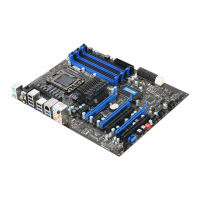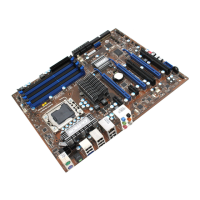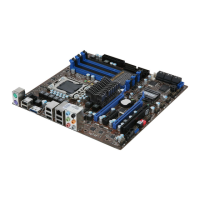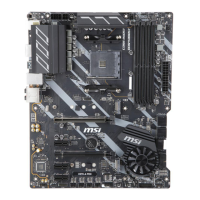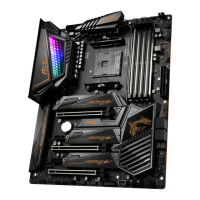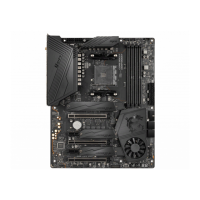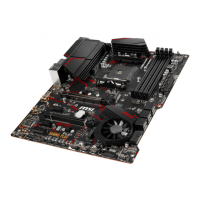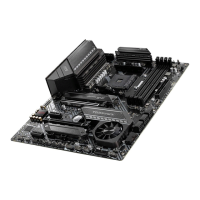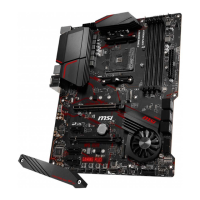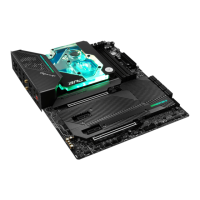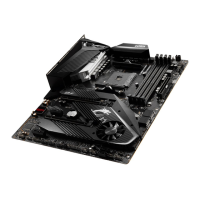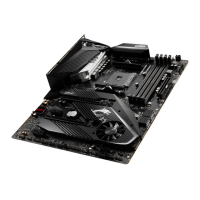Do you have a question about the MSI X58A-GD45 series and is the answer not in the manual?
Provides copyright and intellectual property information for the document.
Lists registered trademarks of various companies relevant to the product.
Details the revision history and release date of the manual.
Provides contact information and resources for technical assistance.
Details FCC regulations regarding radio frequency interference and device compliance.
Information on the disposal of Waste Electrical and Electronic Equipment (WEEE) directive.
Detailed specifications of the X58A-GD45 series mainboard components.
Diagram illustrating the location of onboard components and connectors.
Lists the items included in the mainboard package.
Identifies key onboard components and their locations on the mainboard.
Step-by-step instructions for installing the CPU and cooler correctly.
Guidelines for installing DDR3 memory modules in various channel modes.
Details about ATX 24-pin (JPWR1) and 8-pin (JPWR3) power connectors.
Description of rear I/O ports including USB, LAN, Audio, and S/PDIF.
Details internal connectors for SATA, fans, USB, audio, and front panel.
Information on jumpers (JBAT1) and onboard buttons (Power, Reset).
Details on PCI Express and PCI slots and PCI interrupt routing.
Explanation of onboard LEDs for power phase (APS) and HDD status.
Steps to access the BIOS setup utility by pressing the DEL key.
Overview of control keys and the main menu structure for BIOS setup.
Configuration of basic system settings like date, time, and SATA devices.
Setup options for boot sequence, logo display, and system performance.
Enabling/disabling onboard controllers like USB, LAN, SATA, and Audio.
Configuration of ACPI, sleep states, and power saving options.
Monitoring system health status like temperatures, fan speeds, and voltages.
Setting up supervisor and user passwords for BIOS access control.
Advanced settings for CPU, DRAM, and QPI frequency, voltage, and timings.
Procedure for updating the BIOS using the M-Flash utility from a storage drive.
Saving and loading custom overclocking settings to/from profiles.
Restoring system settings to Fail-Safe or Optimized defaults.
Steps to install the Realtek HD audio driver for proper audio functionality.
Overview of the Realtek HD Audio Manager panel and its features.
Diagrams showing audio jack connections for 2-channel and 4-channel speaker setups.
Overview of SATA hard drives and Intel RAID controller features.
Entering and using the Intel RAID Option ROM utility for configuration.
Step-by-step guide to creating RAID volumes using the utility.
Procedures for deleting RAID volumes and resetting disks to non-RAID.
Instructions for installing the Intel RAID driver during OS installation.
Steps to handle degraded RAID arrays due to missing or failed drives.
Overview of the Marvell BIOS setup utility and its interface.
Procedure for creating virtual disks using the Marvell RAID utility.
Steps to delete virtual disks managed by the Marvell RAID controller.
Procedure to manually rebuild a degraded Marvell RAID virtual disk.
Instructions for installing Marvell RAID drivers for bootable arrays.
| Form Factor | ATX |
|---|---|
| Socket Type | LGA 1366 |
| Chipset | Intel X58 |
| Memory Type | DDR3 |
| Memory Slots | 6 |
| Maximum Memory Support | 24GB |
| PCI Express x16 Slots | 3 |
| SATA 6Gb/s | 2 |
| RAID Support | 0, 1, 5, 10 |
| USB 3.0 | 2 |
| USB 2.0 Ports | 6 |
| Audio Chipset | Realtek ALC889 |
| Audio | 8-channel HD Audio |
| Ethernet | 1 |
| LAN | Realtek RTL8111E |
